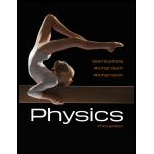
Concept explainers
(a)
The wavelengths that can be absorbed by the hydrogen atom.
(a)
Answer to Problem 64P
The wavelengths that can be absorbed by the hydrogen atom are
Explanation of Solution
Given that the wavelength of the UV light is ranging from
The photons that can be absorbed have energies equal to the energy difference between the energy levels of the hydrogen atom.
Write the expression for the difference in energy between the ground state and
Here,
Write the expression for the energy of the
Use equation (II) in (I).
Write the expression for the absorbed wavelength corresponding to the energy level difference.
Here,
Use equation (III) in (IV).
The value of
Conclusion:
Substitute
Substitute
Substitute
Substitute
Substitute
Therefore, the wavelengths that can be absorbed by the hydrogen atom are
(b)
The recoil speed of the atom after absorption of the UV photons corresponding to the absorbing wavelengths.
(b)
Answer to Problem 64P
The recoil speed of the atom after absorption of the UV photons corresponding to
Explanation of Solution
According to the momentum conservation, the momentum of the photon must be equal to the momentum of the atom after absorbing the photon from rest.
Write the expression for the momentum of the photon.
Here,
Write the expression for the momentum of the hydrogen atom after absorption of photon.
Here,
Equate the right hand sides of equation (VI) and (VII) and solve for
Conclusion:
Substitute
Substitute
Therefore, the recoil speed of the atom after absorption of the UV photons corresponding to
(c)
The number of ways in which the hydrogen atom returns to the ground state after absorption.
(c)
Answer to Problem 64P
The hydrogen atom returns to the ground state in two ways after absorption of
Explanation of Solution
The transition from the
Conclusion:
Therefore, the hydrogen atom returns to the ground state in two ways after absorption of
Want to see more full solutions like this?
Chapter 27 Solutions
Student Solutions Manual for Physics
 College PhysicsPhysicsISBN:9781305952300Author:Raymond A. Serway, Chris VuillePublisher:Cengage Learning
College PhysicsPhysicsISBN:9781305952300Author:Raymond A. Serway, Chris VuillePublisher:Cengage Learning University Physics (14th Edition)PhysicsISBN:9780133969290Author:Hugh D. Young, Roger A. FreedmanPublisher:PEARSON
University Physics (14th Edition)PhysicsISBN:9780133969290Author:Hugh D. Young, Roger A. FreedmanPublisher:PEARSON Introduction To Quantum MechanicsPhysicsISBN:9781107189638Author:Griffiths, David J., Schroeter, Darrell F.Publisher:Cambridge University Press
Introduction To Quantum MechanicsPhysicsISBN:9781107189638Author:Griffiths, David J., Schroeter, Darrell F.Publisher:Cambridge University Press Physics for Scientists and EngineersPhysicsISBN:9781337553278Author:Raymond A. Serway, John W. JewettPublisher:Cengage Learning
Physics for Scientists and EngineersPhysicsISBN:9781337553278Author:Raymond A. Serway, John W. JewettPublisher:Cengage Learning Lecture- Tutorials for Introductory AstronomyPhysicsISBN:9780321820464Author:Edward E. Prather, Tim P. Slater, Jeff P. Adams, Gina BrissendenPublisher:Addison-Wesley
Lecture- Tutorials for Introductory AstronomyPhysicsISBN:9780321820464Author:Edward E. Prather, Tim P. Slater, Jeff P. Adams, Gina BrissendenPublisher:Addison-Wesley College Physics: A Strategic Approach (4th Editio...PhysicsISBN:9780134609034Author:Randall D. Knight (Professor Emeritus), Brian Jones, Stuart FieldPublisher:PEARSON
College Physics: A Strategic Approach (4th Editio...PhysicsISBN:9780134609034Author:Randall D. Knight (Professor Emeritus), Brian Jones, Stuart FieldPublisher:PEARSON





